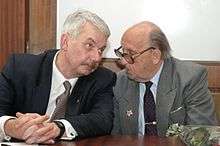Institute for US and Canadian Studies
|
| |
| Type | Public |
|---|---|
| Established | 1967 |
| Location | Moscow, Russia |
| Website | http://www.iskran.ru/ |
Institute for US and Canadian Studies (Russian: Институт США и Канады РАН, Institut SShA i Kanadi RAN) is a Russian think tank which is part of the Russian Academy of Sciences, specializing on the comprehensive studies of the United States and Canada.
ISKRAN was founded by Dr. Georgy Arbatov in 1967, who led the institute until 1995. Since that time it has been the main Soviet and later Russian center of research of American and Canadian foreign and internal policy.
ISKRAN in 1967–1991
Founded in the late 1960s and originally known as the USA Institute, its name was subsequently changed to the USA and Canada Institute to reflect an expanded geographic focus. It was one of a number of area studies organizations created by the Soviet government to engage in unfettered research on regional issues; former institute director Georgy Arbatov referred to these organizations as "oases of creative thought".[1]
By the late 1980s the institute had a staff of 300 specialists and published a monthly scholarly journal, U.S.A.: Economics, Politics, Ideology.[2]
ISKRAN played an important role in the Soviet foreign policy decision making process. Its specialists were responsible for providing unbiased information to Soviet top leaders on the economies, and political and military development of the United States. ISKRAN also included a doctoral department which provided highly competitive scholarships for American studies. ISKRAN specialists were among the architects of Soviet detente policy and later assisted Soviet leaders in preparing all major arms control deals with the United States. The head of the institute, Arbatov, was a personal adviser to Brezhnev, Andropov, Chernenko, and Gorbachev. Since ISKRAN specialists had direct access to the data from the Western bloc, they managed to overcome ideological barriers and to better understand the internal situation in the Soviet Union and the Communist bloc in the late 1970s to early 1980s. Thus ISKRAN was one of the major Soviet institutes initiating and supporting Gorbachev's policy of perestroika in 1985. U.S.-based critics of the USA and Canada Institute accused it of being an active measures initiative whose purpose was to spread disinformation in the United States.[3]
ISKRAN after 1991

ISKRAN remained one of the leading Russian think tanks after the collapse of the Soviet Union. It continued its studies of international political, economic, and military issues. ISKRAN retained its functions of political and economic consultations of major Russian government bodies. Currently the institute is headed by Sergey Rogov.[4] The institute arranges conferences, workshops, and debates on major issues of international relations. Many Russian and foreign scholars and policymakers give their lectures for ISKRAN. Some of Russian prominent policymakers have studied or worked at ISKRAN.
In 2007 ISKRAN was included in the list of the world leading think-tanks.[5]
USA-Canada: Economics, Politics, Culture Journal
The institute continues to publish the monthly journal USA-Canada: Economics, Politics, Culture, which was founded in 1970. The journal is one of the leading Russian foreign policy magazines. It has a strong reputation for thoughtful, analytical, and unbiased articles by major Russian scholars and PhD students.[4]
References
- ↑ Chubarov, Alexander (2001). Russia's Bitter Path to Modernity: A History of the Soviet and Post-Soviet Eras. Continuum. pp. 155–156. ISBN 0826413501.
- ↑ Staar, Richard (1987). USSR Foreign Policies After Detente. Hoover Institution. ISBN 0817985921.
- ↑ "Unmasking Moscow's 'Institute of the U.S.A.'". The Heritage Foundation. December 17, 1982.
- 1 2 Институт США и Канады РАН (Russian)
- ↑ http://www.fpri.org/research/thinktanks/mcgann.globalgotothinktanks.pdf